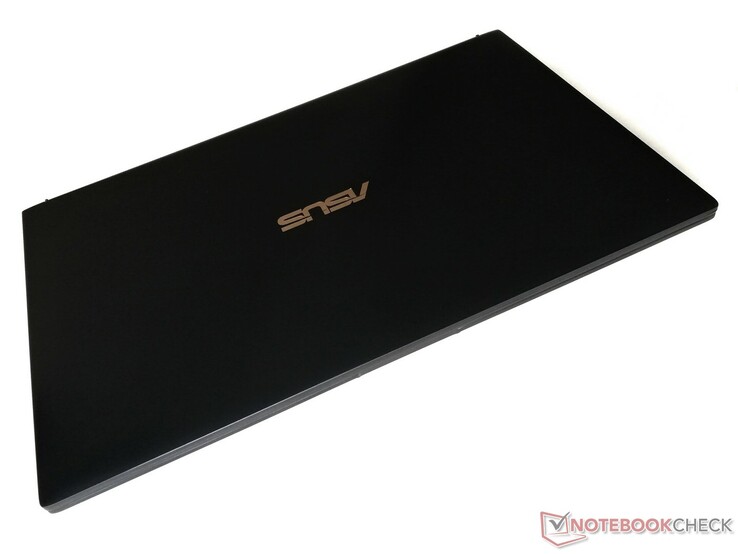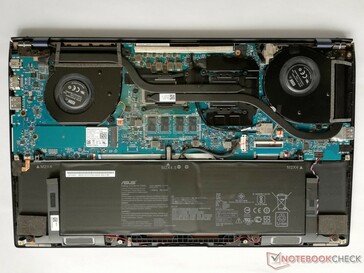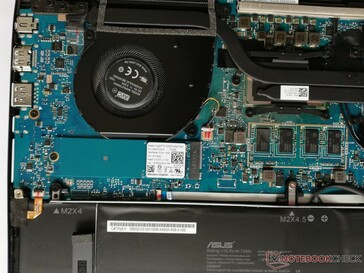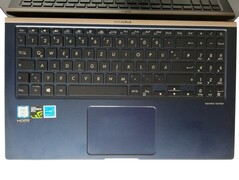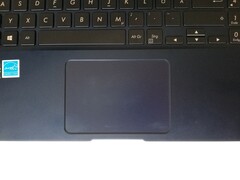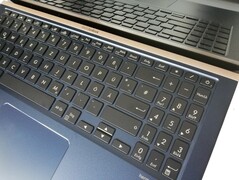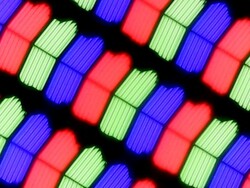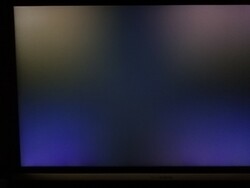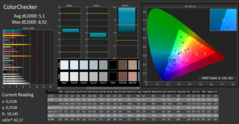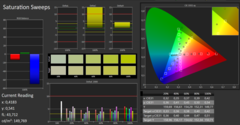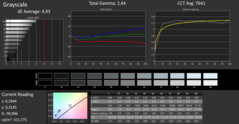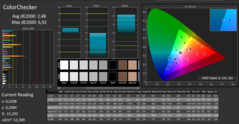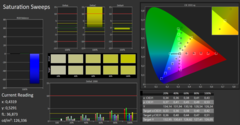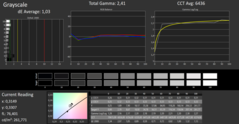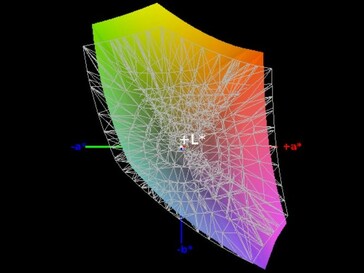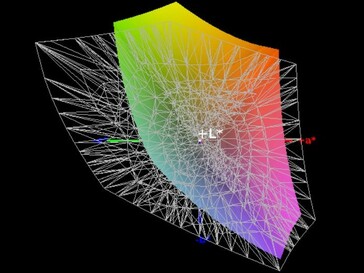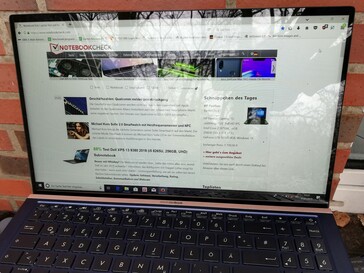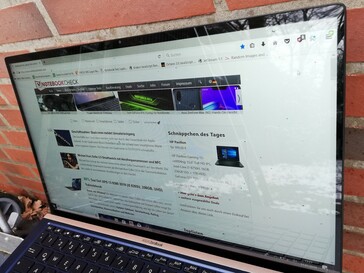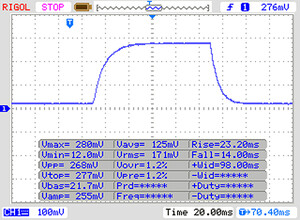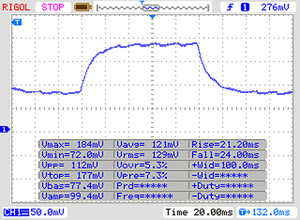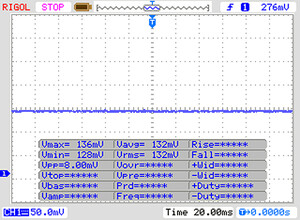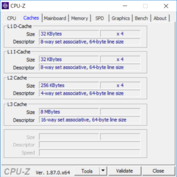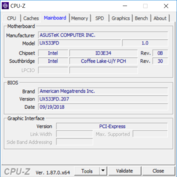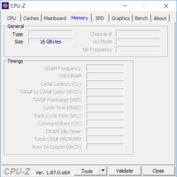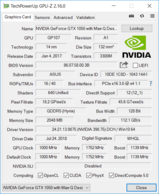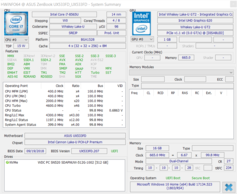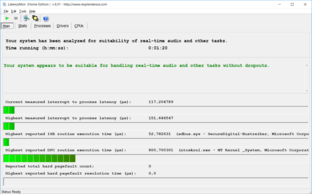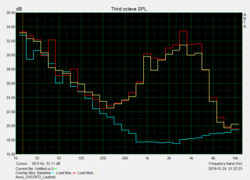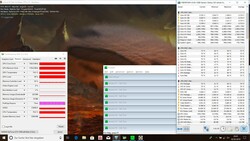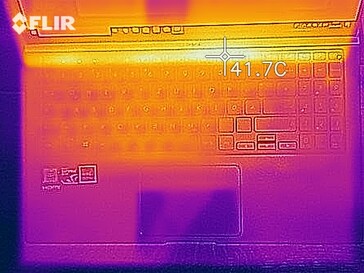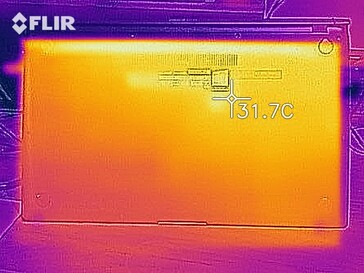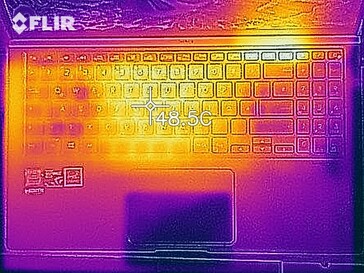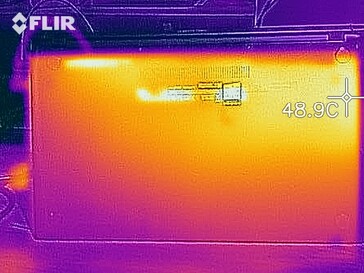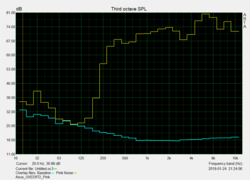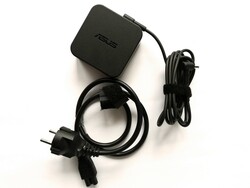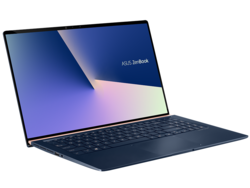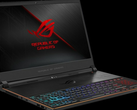Asus ZenBook 15 (i7-8565U, GTX1050 Max-Q) Laptop Review
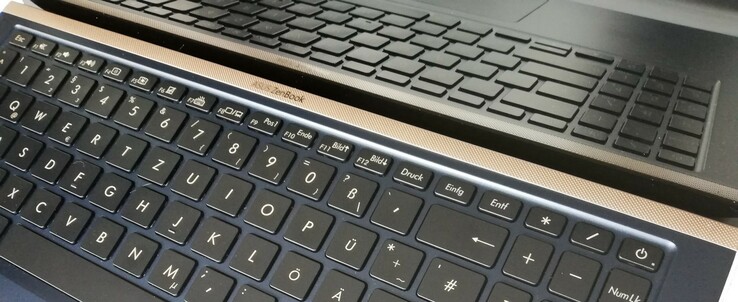
Asus has positioned its notebooks from the ZenBook series as devices with a slim design and a lot of performance. For example, the following ZenBook models known as the UX3410UQ and UX430UN received quite a bit of praise in our reviews, thanks to their slim build and great battery life. Our current review device, known as the Asus ZenBook 15 UX533FD, belongs to the latest generation of laptops in this series and features a 15-inch screen, which is the largest that this series has ever seen. There are also 13- and 14-inch notebooks in this product line, which are branded by Asus as the ZenBook 13 and ZenBook 14, respectively.
The Asus ZenBook 15 UX533FD in our review configuration features an Intel Core i7-8565U with Intel’s integrated UHD Graphics 620. The GeForce GTX 1050 Max-Q from Nvidia is responsible for running demanding 3D applications. Moreover, the laptop features a 512 GB SSD and 16 GB of RAM.
In our review, the Asus ZenBook 15 will have to compete with other notebooks with similar hardware. The competing devices include: The base model of the Razer Blade 15, the Lenovo ThinkPad T580, the HP EliteBook 1050 G1 as well as Asus’s own ZenBook Pro 15 UX580GE.
Case - Rigid and slender Asus notebook
Thanks to its unusual design, the Asus ZenBook 15 stands out when you first look at it: It has very slim bezels. The side bezels are only 3 mm thick and the top bezel is about 6 mm thick. According to the manufacturer, the laptop has a screen-to-body ratio of 92%. The case of the notebook is machined from a solid block of aluminum. The ZenBook 15 comes in the color scheme called “Royal Blue Metal”.
The surfaces of the Asus notebook feel very rigid and robust. The build quality is very good and the decorative element under the screen does not cause any problems. All joints are flush with each other and all the buttons and ports sit firmly in their respective cutouts.
When compared to other notebooks in this price range, the ZenBook 15 has a somewhat similar width. However, it has a much smaller depth. The ZenBook 15 weighs 1.8 kg, which makes it the lightest laptop in our comparison chart.
Connectivity - Laptop with USB 3.1 Gen2 Type-C
The Asus ZenBook 15 features only the most necessary ports. Here the manufacturer forgoes a LAN port and only includes HDMI and USB ports. Standard USB ports only support USB 3.1 speeds (up to 5 Gb/s). However, the USB Type-C port can operate at Gen2 speeds (up to 10 Gb/s). This is why the Type-C port should be compatible with almost any dock that relies on USB-C technology. Moreover, you can also output a video signal over the USB Type-C port.
SD Card Reader
In our benchmarks, the SD card reader of the ZenBook 15 delivers subpar results. With a read rate of 78 MB/s and a write rate of 65.6 MB/s, the Asus laptop takes a spot near the bottom of our comparison chart.
The inserted SD cards protrude from the slot by about half a centimeter, which is why they have to be removed when you are transporting the device.
| SD Card Reader | |
| average JPG Copy Test (av. of 3 runs) | |
| HP EliteBook 1050 G1-4QY20EA (Toshiba Exceria Pro SDXC 64 GB UHS-II) | |
| Average of class Multimedia (17.6 - 205, n=66, last 2 years) | |
| Lenovo ThinkPad T580-20L9001AUS (Toshiba Exceria Pro SDXC 64 GB UHS-II) | |
| Asus ZenBook 15 UX533FD (Toshiba Exceria Pro SDXC 64 GB UHS-II) | |
| Asus ZenBook Pro 15 UX580GE (Toshiba Exceria Pro M501 UHS-II) | |
| maximum AS SSD Seq Read Test (1GB) | |
| HP EliteBook 1050 G1-4QY20EA (Toshiba Exceria Pro SDXC 64 GB UHS-II) | |
| Average of class Multimedia (16.8 - 266, n=62, last 2 years) | |
| Lenovo ThinkPad T580-20L9001AUS (Toshiba Exceria Pro SDXC 64 GB UHS-II) | |
| Asus ZenBook 15 UX533FD (Toshiba Exceria Pro SDXC 64 GB UHS-II) | |
Communication
The ZenBook 15 comes with Intel’s Wireless-AC 9560 adapter. It supports the following wireless communication standards: 802.11 a, b, g, n and ac. Thanks to a 2x2 MIMO antenna, the Asus notebook achieves an upload speed of 644 Mb/s and a download speed of 651 Mb/s. These results are on a normal level for this kind of device.
Security
Thanks to its infrared webcam, the Asus ZenBook 15 can take advantage of Microsoft’s biometric facial recognition feature known as Windows Hello. It works well as long as the lighting is sufficiently bright. In poor lighting conditions, the facial recognition feature does not function properly, which often leads to failed log-in attempts.
Accessories
The box contains a 90-watt charger and a cleaning cloth. Asus does not offer any additional accessories for the ZenBook 15. However, you can get general accessories such as mice, headphones and keyboards from Asus’s online store.
Maintenance
Warranty
The ZenBook 15 comes with a 24-month warranty. Please see our Guarantees, Return policies and Warranties article for country-specific information.
Input Devices - Asus notebook with a large Touchpad
Keyboard
The keyboard of the Asus ZenBook 15 is easy to type on. It offers a short travel distance and a clear actuation point. The keys are flat and have a smooth surface. This is why fingers often do not land in the center of the key. It takes some getting used to, but eventually even long typing sessions do not present any difficulties. Nevertheless, users will often have to look down at the keyboard to make sure that they have pressed the right key. The arrow and function keys are also rather small. Asus makes up for that by including a numeric pad.
For work in poor lighting conditions, the notebook comes with a three-level keyboard backlight. The backlight is somewhat uneven. Because of this, the keys in the center appear noticeably dimmer than the keys at the edges. Furthermore, the keyboard backlight shines through the cutouts for the keys and slightly blinds users.
Touchpad
The ZenBook 15 uses a ClickPad as a replacement for the mouse. It offers a large surface area for navigating the mouse pointer and registers multitouch inputs flawlessly. Pressing in the left bottom corner executes the left click. The actuation point is shallow, but not so shallow that it can cause accidental clicks. A right click is harder to execute. The ClickPad registers right clicks only when a lot of force is applied, and the actuation point does not feel very clear at all.
Display - Glossy Full HD screen
The 15.6-inch screen of our review device has a resolution of 1920x1080 and a 16:9 aspect ratio. The brightness of 303 cd/m² is quite average. However, it is still high enough to overpower the reflections in rooms lit by the sun. We measured 311 cd/m² in the center of the display, which is why the Asus notebook takes a spot in the middle of our comparison chart. The brightness distribution of 81% is the lowest result in our comparison group.
Asus also offers a variant of the ZenBook 15 with a UHD display that has a resolution of 3840x2160.
| |||||||||||||||||||||||||
Brightness Distribution: 81 %
Center on Battery: 311 cd/m²
Contrast: 1296:1 (Black: 0.24 cd/m²)
ΔE Color 5.1 | 0.5-29.43 Ø5, calibrated: 2.48
ΔE Greyscale 4.93 | 0.57-98 Ø5.3
88% sRGB (Argyll 1.6.3 3D)
58% AdobeRGB 1998 (Argyll 1.6.3 3D)
64.6% AdobeRGB 1998 (Argyll 2.2.0 3D)
88.4% sRGB (Argyll 2.2.0 3D)
67.2% Display P3 (Argyll 2.2.0 3D)
Gamma: 2.44
| Asus ZenBook 15 UX533FD BOE07D8, , 1920x1080, 15.60 | Razer Blade 15 Base Model BOE NV156FHM-N61, , 1920x1080, 15.60 | Lenovo ThinkPad T580-20L9001AUS B156HAK02.0, , 1920x1080, 15.60 | HP EliteBook 1050 G1-4QY20EA AUO30EB, , 3840x2160, 15.60 | Asus ZenBook Pro 15 UX580GE AU Optronics B156ZAN03.1, , 3840x2160, 15.60 | |
|---|---|---|---|---|---|
| Display | -2% | -41% | 4% | 31% | |
| Display P3 Coverage | 67.2 | 66.3 -1% | 36.94 -45% | 67.8 1% | 85.9 28% |
| sRGB Coverage | 88.4 | 86.6 -2% | 55.3 -37% | 94.1 6% | 100 13% |
| AdobeRGB 1998 Coverage | 64.6 | 63.3 -2% | 38.16 -41% | 67.9 5% | 99.1 53% |
| Response Times | 9% | 26% | -1% | 20% | |
| Response Time Grey 50% / Grey 80% * | 45 ? | 39.2 ? 13% | 33.2 ? 26% | 56 ? -24% | 44 ? 2% |
| Response Time Black / White * | 37 ? | 35.2 ? 5% | 27.6 ? 25% | 29 ? 22% | 22.8 ? 38% |
| PWM Frequency | 21190 ? | ||||
| Screen | -2% | -26% | 7% | 3% | |
| Brightness middle | 311 | 273.6 -12% | 254.5 -18% | 440 41% | 357.6 15% |
| Brightness | 303 | 262 -14% | 238 -21% | 389 28% | 350 16% |
| Brightness Distribution | 81 | 86 6% | 87 7% | 83 2% | 85 5% |
| Black Level * | 0.24 | 0.3 -25% | 0.27 -13% | 0.34 -42% | 0.35 -46% |
| Contrast | 1296 | 912 -30% | 943 -27% | 1294 0% | 1022 -21% |
| Colorchecker dE 2000 * | 5.1 | 3.22 37% | 4.58 10% | 5.04 1% | 4.12 19% |
| Colorchecker dE 2000 max. * | 8.91 | 7.61 15% | 17.99 -102% | 6.99 22% | 9.91 -11% |
| Colorchecker dE 2000 calibrated * | 2.48 | 4.1 -65% | 4.34 -75% | 2.04 18% | 4.23 -71% |
| Greyscale dE 2000 * | 4.93 | 1.4 72% | 3.3 33% | 4.98 -1% | 1.8 63% |
| Gamma | 2.44 90% | 2.24 98% | 2.403 92% | 2.48 89% | 2.17 101% |
| CCT | 7641 85% | 6636 98% | 6355 102% | 7777 84% | 6613 98% |
| Color Space (Percent of AdobeRGB 1998) | 58 | 56.4 -3% | 35 -40% | 61 5% | 87.5 51% |
| Color Space (Percent of sRGB) | 88 | 86.2 -2% | 55 -37% | 94 7% | 100 14% |
| Total Average (Program / Settings) | 2% /
-1% | -14% /
-22% | 3% /
6% | 18% /
11% |
* ... smaller is better
According to our measurements, the screen of the ZenBook 15 has a very good contrast ratio of 1296:1 and a good black value of 0.24 cd/m². These are the second-best results in our comparison group.
The CalMAN analysis reveals that the blue part of the color spectrum overshoots its target and that the red part undershoots it. This issue can be completely resolved through calibration. You can download our ICC profile at the bottom of the box that contains all the display measurements (this box is located to the left of the graphic showing the distribution of brightness).
The Asus ZenBook 15 is not suited for outdoor use. Even on overcast winter days, the reflections make reading screen content very hard. Indoors, the reflections do not become too bothersome during the day. Artificial light sources also create reflections that make reading screen content more difficult.
Display Response Times
| ↔ Response Time Black to White | ||
|---|---|---|
| 37 ms ... rise ↗ and fall ↘ combined | ↗ 23 ms rise | |
| ↘ 14 ms fall | ||
| The screen shows slow response rates in our tests and will be unsatisfactory for gamers. In comparison, all tested devices range from 0.1 (minimum) to 240 (maximum) ms. » 94 % of all devices are better. This means that the measured response time is worse than the average of all tested devices (21.5 ms). | ||
| ↔ Response Time 50% Grey to 80% Grey | ||
| 45 ms ... rise ↗ and fall ↘ combined | ↗ 21 ms rise | |
| ↘ 24 ms fall | ||
| The screen shows slow response rates in our tests and will be unsatisfactory for gamers. In comparison, all tested devices range from 0.2 (minimum) to 636 (maximum) ms. » 73 % of all devices are better. This means that the measured response time is worse than the average of all tested devices (33.7 ms). | ||
Screen Flickering / PWM (Pulse-Width Modulation)
| Screen flickering / PWM not detected | |||
In comparison: 53 % of all tested devices do not use PWM to dim the display. If PWM was detected, an average of 17900 (minimum: 5 - maximum: 3846000) Hz was measured. | |||
Performance - Light and gaming-capable notebook
Our review device comes with Intel’s Core i7-8565U, Nvidia’s GeForce GTX 1050 Max-Q, 16 GB of RAM and a 512 GB SSD. Therefore, the laptop is not only suitable for demanding applications but also for gaming on medium settings.
There is also a cheaper version of the Asus ZenBook 15 that has Intel’s Core i5-8265U, Nvidia’s GeForce GTX 1050 Max-Q and 8 GB of RAM.
Processor
Thanks to the Core i7-8565U, the system feels very responsive. This CPU is based on the Whiskey Lake architecture and features four cores. Because it supports Hyper-Threading, it can process up to eight threads at the same time. The clock rates range from 1800 MHz to 4600 MHz. Additionally, the processor also has a dual-channel-enabled memory controller, which allows both RAM sticks in our review device to operate optimally.
In the single-core section of Cinebench R15, the Intel Core i7-8565U in the Asus ZenBook 15 performs as well as the Intel Core i9-8950HK in the Asus ZenBook Pro 15. However, the multi-core performance falls well below that of the Intel Core i7-8750H. All in all, the CPU performance of the ZenBook 15 is above average.
System Performance
The Asus ZenBook 15 achieves good results in the PCMark benchmarks. It takes a spot in the middle of our comparison chart and outperforms almost all other devices with an Intel Core i7-8565U and a GeForce GTX 1050 Max-Q. The apps start very fast and accessing data and opening folders does not present any problems.
You can find out how the Asus ZenBook 15 stacks up against other laptops on our CPU Benchmarks page.
| PCMark 8 Home Score Accelerated v2 | 4052 points | |
| PCMark 8 Work Score Accelerated v2 | 5381 points | |
| PCMark 10 Score | 4443 points | |
Help | ||
Storages Devices
Our review model of the Asus ZenBook 15 comes with a 512 GB SSD. It achieves similar read and write rates to other notebooks with comparable storage devices. In day-to-day use, folders and files open without any delays. The programs start quickly and the system boots up very fast. Besides a 512 GB SSD, you can also choose either a 256 GB SSD or a 1 TB SSD.
You can find out how the Asus ZenBook 15’s storage device stacks up against other HDDs and SSDs on our HDD/SSD Benchmarks page.
| Asus ZenBook 15 UX533FD WDC PC SN520 SDAPNUW-512G | Razer Blade 15 Base Model Samsung SSD PM981 MZVLB256HAHQ | Lenovo ThinkPad T580-20L9001AUS Samsung SSD PM981 MZVLB512HAJQ | HP EliteBook 1050 G1-4QY20EA Toshiba XG5-P KXG50PNV2T04 | Asus ZenBook Pro 15 UX580GE Samsung SSD PM961 1TB M.2 PCIe 3.0 x4 NVMe (MZVLW1T0) | Average WDC PC SN520 SDAPNUW-512G | |
|---|---|---|---|---|---|---|
| CrystalDiskMark 5.2 / 6 | 22% | -4% | -1% | 17% | 12% | |
| Write 4K | 126.2 | 112.5 -11% | 122.1 -3% | 94.8 -25% | 125 -1% | 138.5 ? 10% |
| Read 4K | 41.2 | 43.09 5% | 44.61 8% | 26.45 -36% | 44.68 8% | 44.2 ? 7% |
| Write Seq | 1055 | 1450 37% | 826 -22% | 1037 -2% | 1059 0% | 1265 ? 20% |
| Read Seq | 884 | 1392 57% | 811 -8% | 1280 45% | 772 -13% | 1237 ? 40% |
| Write 4K Q32T1 | 445.5 | 356.1 -20% | 293.9 -34% | 277.6 -38% | 507 14% | 404 ? -9% |
| Read 4K Q32T1 | 338.8 | 406.9 20% | 374.8 11% | 333.9 -1% | 614 81% | 421 ? 24% |
| Write Seq Q32T1 | 1453 | 1451 0% | 1714 18% | 1037 -29% | 1763 21% | 1491 ? 3% |
| Read Seq Q32T1 | 1734 | 3272 89% | 1772 2% | 3135 81% | 2171 25% | 1741 ? 0% |
| Write 4K Q8T8 | 1044 | 715 ? | ||||
| Read 4K Q8T8 | 914 | 1027 ? | ||||
| AS SSD | 31% | 46% | 26% | 69% | 29% | |
| Seq Read | 579 | 1803 211% | 1454 151% | 2454 324% | 2099 263% | 1363 ? 135% |
| Seq Write | 411.8 | 1367 232% | 1324 222% | 948 130% | 1729 320% | 1227 ? 198% |
| 4K Read | 41.81 | 40.75 -3% | 50.8 22% | 19.07 -54% | 37.78 -10% | 40.8 ? -2% |
| 4K Write | 131.6 | 93 -29% | 106.2 -19% | 105.4 -20% | 100.9 -23% | 127.3 ? -3% |
| 4K-64 Read | 975 | 749 -23% | 1140 17% | 856 -12% | 1431 47% | 957 ? -2% |
| 4K-64 Write | 1047 | 1270 21% | 1325 27% | 953 -9% | 1273 22% | 1081 ? 3% |
| Access Time Read * | 0.08 | 0.113 -41% | 0.047 41% | 0.051 36% | 0.04 50% | 0.07744 ? 3% |
| Access Time Write * | 0.027 | 0.04 -48% | 0.035 -30% | 0.056 -107% | 0.036 -33% | 0.03671 ? -36% |
| Score Read | 1075 | 970 -10% | 1336 24% | 1120 4% | 1679 56% | 1134 ? 5% |
| Score Write | 1220 | 1499 23% | 1564 28% | 1153 -5% | 1547 27% | 1331 ? 9% |
| Score Total | 2845 | 2952 4% | 3587 26% | 2768 -3% | 4065 43% | 3046 ? 7% |
| Copy ISO MB/s | 1892 | 2507 | 1045 | 1169 ? | ||
| Copy Program MB/s | 495.5 | 395.4 | 430.9 | 446 ? | ||
| Copy Game MB/s | 1070 | 1129 | 728 | 874 ? | ||
| Total Average (Program / Settings) | 27% /
27% | 21% /
25% | 13% /
15% | 43% /
47% | 21% /
22% |
* ... smaller is better
Graphics Card
The Asus ZenBook 15 has Intel’s integrated UHD Graphics 620 and Nvidia’s dedicated GeForce GTX 1050 Max-Q. While Intel’s graphics unit provides enough performance for simple programs and the OS, the GeForce GTX 1050 Max-Q is used to run complex 3D applications. Unlike many GeForce graphics cards without the “Max-Q” designation, this GPU is specifically tuned for efficiency, which is why it offers a little less performance but produces a lot less fan noise. The performance also depends on the cooling solution.
The Asus notebook achieves the highest results in the 3DMark benchmarks that we have ever seen from a laptop with a GTX 1050 Max-Q. You can also see in our comparison chart how much performance you are going to lose if you go with a notebook with Intel’s integrated UHD Graphics 620. When compared to the Asus ZenBook Pro 15, which has a GeForce GTX 1050 Ti, the ZenBook 15 is about 20% slower.
You can learn what kind of performance you can expect from Nvidia’s GTX 1050 Max-Q on our GPU Benchmarks page.
| 3DMark 06 Standard Score | 9694 points | |
| 3DMark 11 Performance | 7116 points | |
| 3DMark Cloud Gate Standard Score | 17993 points | |
| 3DMark Fire Strike Score | 5209 points | |
Help | ||
Gaming Performance
During gaming sessions, the Nvidia GeForce GTX 1050 Max-Q is utilized. This GPU is optimized for energy-efficiency and low fan noise. This is why the fan noise does not exceed 40 dB(A).
Nvidia’s GeForce GTX 1050 Max-Q is available in many different configurations. The ZenBook 15 comes with the lowest configuration that has a core clock of 1000 MHz and 2 GB of GDDR 5 video memory. Nevertheless, the Asus notebook is still powerful enough to be able to run all the latest titles in 1080p on medium settings.
Our benchmarks with the video game titled The Witcher 3 show that the Nvidia GeForce GTX 1050 Max-Q in the ZenBook 15 outperforms other laptops with the same GPU. Moreover, the performance did not fluctuate over the entire run of gameplay. We did not observe any thermal throttling. Many older titles run smoothly on the Asus notebook on the highest settings. All the latest video games can achieve playable frame rates in 1080p on medium settings.
To learn what kind of gaming experience you can expect from Nvidia’s GeForce GTX 1050 Max-Q, go to our Gaming Benchmarks page.
| low | med. | high | ultra | |
| BioShock Infinite (2013) | 266 | 252 | 150 | 59 |
| Thief (2014) | 106 | 76 | 66 | 38 |
| The Witcher 3 (2015) | 64 | 60 | 41 | 30 |
| Rise of the Tomb Raider (2016) | 98 | 62 | 36 | 29 |
Emissions - Windows laptop that has no issues with overheating
System Noise
In everyday use, the Asus ZenBook 15 only produces noise when it is under load. Thanks to Nvidia’s Max-Q technology, the system noise is limited to about 40 dB(A). During our stress test, this limit is slightly exceeded. Having said that, the fan noise never becomes too bothersome.
When running simple apps, the laptop is usually completely silent. This is why the ZenBook 15 is suited for quiet environments, as long as you are not using it to run demanding 3D applications.
Noise Level
| Idle |
| 30.5 / 30.5 / 30.5 dB(A) |
| Load |
| 40.8 / 41.8 dB(A) |
 | ||
30 dB silent 40 dB(A) audible 50 dB(A) loud |
||
min: | ||
Temperature
During our stress test, the surfaces of the Asus ZenBook 15 get noticeably warm. The surface temperatures reach up to 47 °C (116.6 °F) under load. It is not exactly hot, but it is very warm. The heat is concentrated at the bottom of the laptop. The wrist rest area never gets as hot as the rest of the device. The notebook also never gets so hot that you will not be able to keep it in your lap.
Our stress test represents an extreme case scenario. During this test, the core temperatures reach up to 90 °C (194 °F) and the CPU frequency sinks below the base clock rate of 1800 MHz. Once the cooling system kicks in the clock speeds stabilize and remain above the base clock rate for the remainder of the test.
Because such utilization levels are very unlikely to occur in real life, users should not experience any problems related to thermal throttling in day-to-day use.
(-) The maximum temperature on the upper side is 47.2 °C / 117 F, compared to the average of 36.9 °C / 98 F, ranging from 21.1 to 71 °C for the class Multimedia.
(±) The bottom heats up to a maximum of 43.2 °C / 110 F, compared to the average of 39.1 °C / 102 F
(+) In idle usage, the average temperature for the upper side is 25.5 °C / 78 F, compared to the device average of 31.2 °C / 88 F.
(+) The palmrests and touchpad are cooler than skin temperature with a maximum of 30.6 °C / 87.1 F and are therefore cool to the touch.
(±) The average temperature of the palmrest area of similar devices was 28.8 °C / 83.8 F (-1.8 °C / -3.3 F).
Speakers
The ZenBook 15 comes with Harman Kardon-certified speakers. The result is sound with elevated highs and subdued lows. The speakers are good enough for occasional use, but we recommend you get a pair of headphones or external speakers if you want to use the ZenBook 15 for media consumption on a regular basis. These can be connected either via the combined headphone/microphone audio jack or Bluetooth 5.0.
Asus ZenBook 15 UX533FD audio analysis
(±) | speaker loudness is average but good (80.3 dB)
Bass 100 - 315 Hz
(-) | nearly no bass - on average 30.5% lower than median
(±) | linearity of bass is average (13% delta to prev. frequency)
Mids 400 - 2000 Hz
(+) | balanced mids - only 2.3% away from median
(+) | mids are linear (3.2% delta to prev. frequency)
Highs 2 - 16 kHz
(+) | balanced highs - only 4.5% away from median
(±) | linearity of highs is average (7.3% delta to prev. frequency)
Overall 100 - 16.000 Hz
(±) | linearity of overall sound is average (20.6% difference to median)
Compared to same class
» 66% of all tested devices in this class were better, 10% similar, 25% worse
» The best had a delta of 5%, average was 18%, worst was 45%
Compared to all devices tested
» 50% of all tested devices were better, 8% similar, 42% worse
» The best had a delta of 4%, average was 25%, worst was 134%
Apple MacBook 12 (Early 2016) 1.1 GHz audio analysis
(+) | speakers can play relatively loud (83.6 dB)
Bass 100 - 315 Hz
(±) | reduced bass - on average 11.3% lower than median
(±) | linearity of bass is average (14.2% delta to prev. frequency)
Mids 400 - 2000 Hz
(+) | balanced mids - only 2.4% away from median
(+) | mids are linear (5.5% delta to prev. frequency)
Highs 2 - 16 kHz
(+) | balanced highs - only 2% away from median
(+) | highs are linear (4.5% delta to prev. frequency)
Overall 100 - 16.000 Hz
(+) | overall sound is linear (10.2% difference to median)
Compared to same class
» 5% of all tested devices in this class were better, 2% similar, 93% worse
» The best had a delta of 5%, average was 19%, worst was 53%
Compared to all devices tested
» 3% of all tested devices were better, 1% similar, 96% worse
» The best had a delta of 4%, average was 25%, worst was 134%
Energy Management - Good battery life despite a dedicated GPU
Energy Consumption
According to our measurements, the ZenBook 15 draws at least 2.7 watts when idle and up to 89 watts under load. This is why the Asus notebook proves to be the most energy-efficient device with a dedicated graphics card in our comparison chart. Moreover, the Asus ZenBook 15 is also one of the most energy-efficient gaming notebooks that we have ever reviewed.
The included 90-watt AC adapter should be able to provide enough energy to charge the device under any circumstances.
| Off / Standby | |
| Idle | |
| Load |
|
| Asus ZenBook 15 UX533FD i7-8565U, GeForce GTX 1050 Max-Q, WDC PC SN520 SDAPNUW-512G, IPS, 1920x1080, 15.60 | Razer Blade 15 Base Model i7-8750H, GeForce GTX 1060 Max-Q, Samsung SSD PM981 MZVLB256HAHQ, IPS, 1920x1080, 15.60 | Lenovo ThinkPad T580-20L9001AUS i7-8650U, UHD Graphics 620, Samsung SSD PM981 MZVLB512HAJQ, IPS, 1920x1080, 15.60 | HP EliteBook 1050 G1-4QY20EA i7-8750H, GeForce GTX 1050 Max-Q, Toshiba XG5-P KXG50PNV2T04, IPS LED, 3840x2160, 15.60 | Asus ZenBook Pro 15 UX580GE i9-8950HK, GeForce GTX 1050 Ti Mobile, Samsung SSD PM961 1TB M.2 PCIe 3.0 x4 NVMe (MZVLW1T0), IPS, 3840x2160, 15.60 | Average NVIDIA GeForce GTX 1050 Max-Q | Average of class Multimedia | |
|---|---|---|---|---|---|---|---|
| Power Consumption | -99% | 0% | -46% | -127% | -24% | -59% | |
| Idle Minimum * | 2.7 | 10.2 -278% | 4.7 -74% | 6.1 -126% | 11.7 -333% | 4.48 ? -66% | 7.29 ? -170% |
| Idle Average * | 8 | 13.2 -65% | 7.9 1% | 10.2 -28% | 18.5 -131% | 9.58 ? -20% | 11.8 ? -48% |
| Idle Maximum * | 10.6 | 17.6 -66% | 11.4 -8% | 13.4 -26% | 22.8 -115% | 11.6 ? -9% | 14.6 ? -38% |
| Load Average * | 74 | 99.5 -34% | 47.2 36% | 82 -11% | 97.5 -32% | 77.3 ? -4% | 77.7 ? -5% |
| Load Maximum * | 89 | 133.3 -50% | 48.1 46% | 122 -37% | 111.1 -25% | 105.5 ? -19% | 121 ? -36% |
| Witcher 3 ultra * | 113.6 | 102.9 |
* ... smaller is better
Battery Life
In our practically oriented Wi-Fi test, the Asus notebook lasted for eight-and-a-half hours. The ZenBook 15 was only beaten by the HP EliteBook 1050 G1, which has a battery with a bigger capacity. That being said, the 73-Wh battery in the ZenBook 15 achieves longer battery runtimes under load than most other gaming notebooks.
| Asus ZenBook 15 UX533FD i7-8565U, GeForce GTX 1050 Max-Q, 73 Wh | Razer Blade 15 Base Model i7-8750H, GeForce GTX 1060 Max-Q, 65 Wh | Lenovo ThinkPad T580-20L9001AUS i7-8650U, UHD Graphics 620, 56 Wh | HP EliteBook 1050 G1-4QY20EA i7-8750H, GeForce GTX 1050 Max-Q, 96 Wh | Asus ZenBook Pro 15 UX580GE i9-8950HK, GeForce GTX 1050 Ti Mobile, 71 Wh | Average of class Multimedia | |
|---|---|---|---|---|---|---|
| Battery Runtime | -47% | -51% | -20% | -44% | -25% | |
| Reader / Idle | 1587 | 690 -57% | 1027 -35% | 842 -47% | 933 ? -41% | |
| WiFi v1.3 | 519 | 330 -36% | 252 -51% | 523 1% | 375 -28% | 572 ? 10% |
| Load | 171 | 87 -49% | 128 -25% | 76 -56% | 97.7 ? -43% |
Verdict - Mobile multimedia notebook from Asus
Pros
Cons
In our review, the Asus ZenBook 15 has proven itself to be a very powerful, highly mobile notebook that can run current video games. The slim build, great battery life, and the low weight make the Asus notebook all the more suitable for use on the go. However, those who want to use the ZenBook 15 for gaming will have to keep it plugged in most of the time.
The Asus ZenBook 15 is a compact gaming notebook that can handle all the latest titles. Moreover, it also excels when it comes to battery life.
With the ZenBook 15, Asus delivers a device with very good hardware that can meet the needs of most users. The missing ports can be replicated using the USB 3.1 Gen2 Type-C port and the SSD can be replaced, if need be. There are no other upgrade options. However, given the fact that our review device ships with 16 GB of RAM, this becomes a bit of a moot point. Thanks to Nvidia’s Max-Q technology, Asus is able to keep the temperatures in check. There are no performance drops, at least while gaming.
Asus ZenBook 15 UX533FD
-
02/14/2019 v6(old)
Mike Wobker


 Deutsch
Deutsch English
English Español
Español Français
Français Italiano
Italiano Nederlands
Nederlands Polski
Polski Português
Português Русский
Русский Türkçe
Türkçe Svenska
Svenska Chinese
Chinese Magyar
Magyar